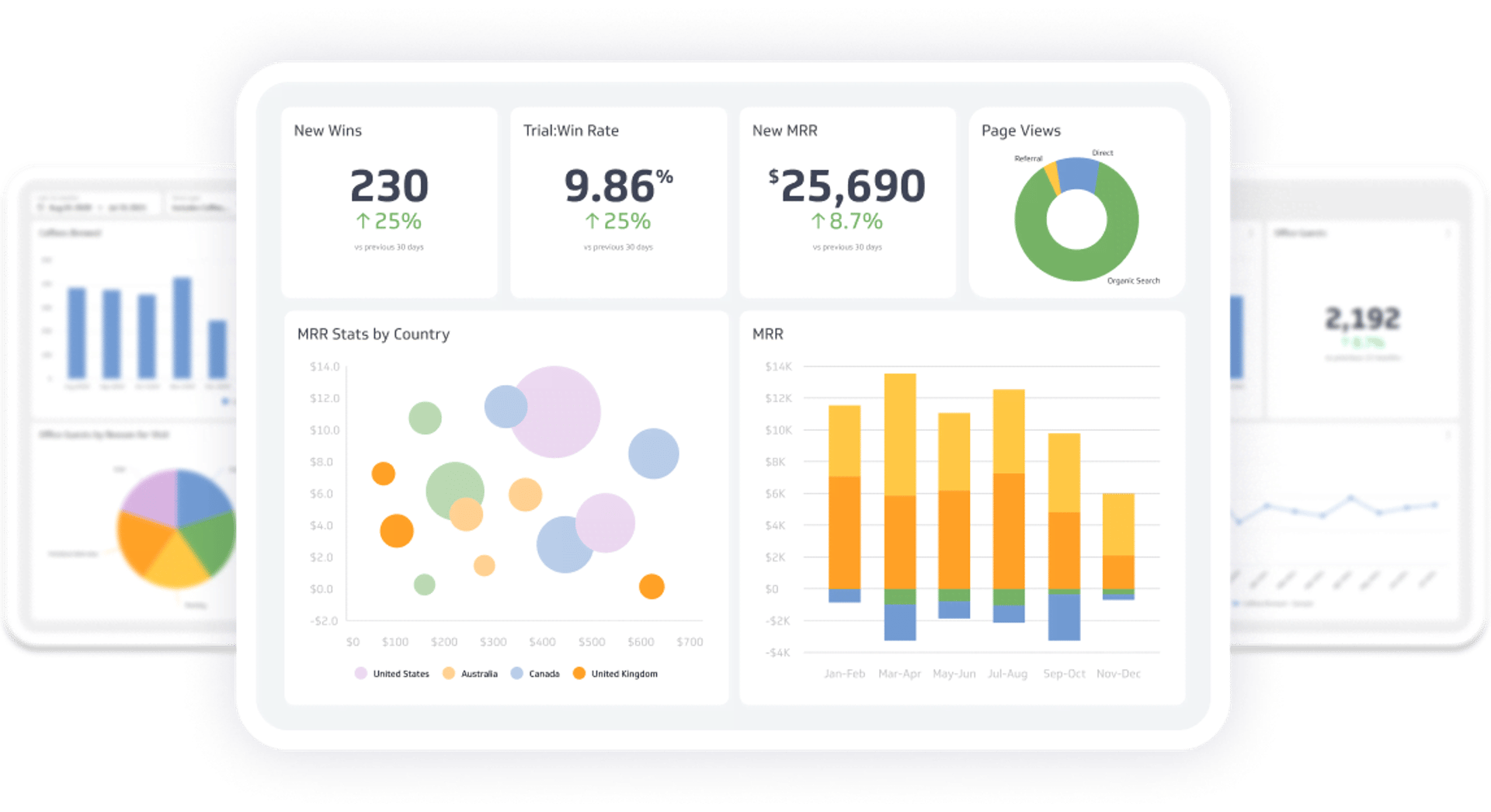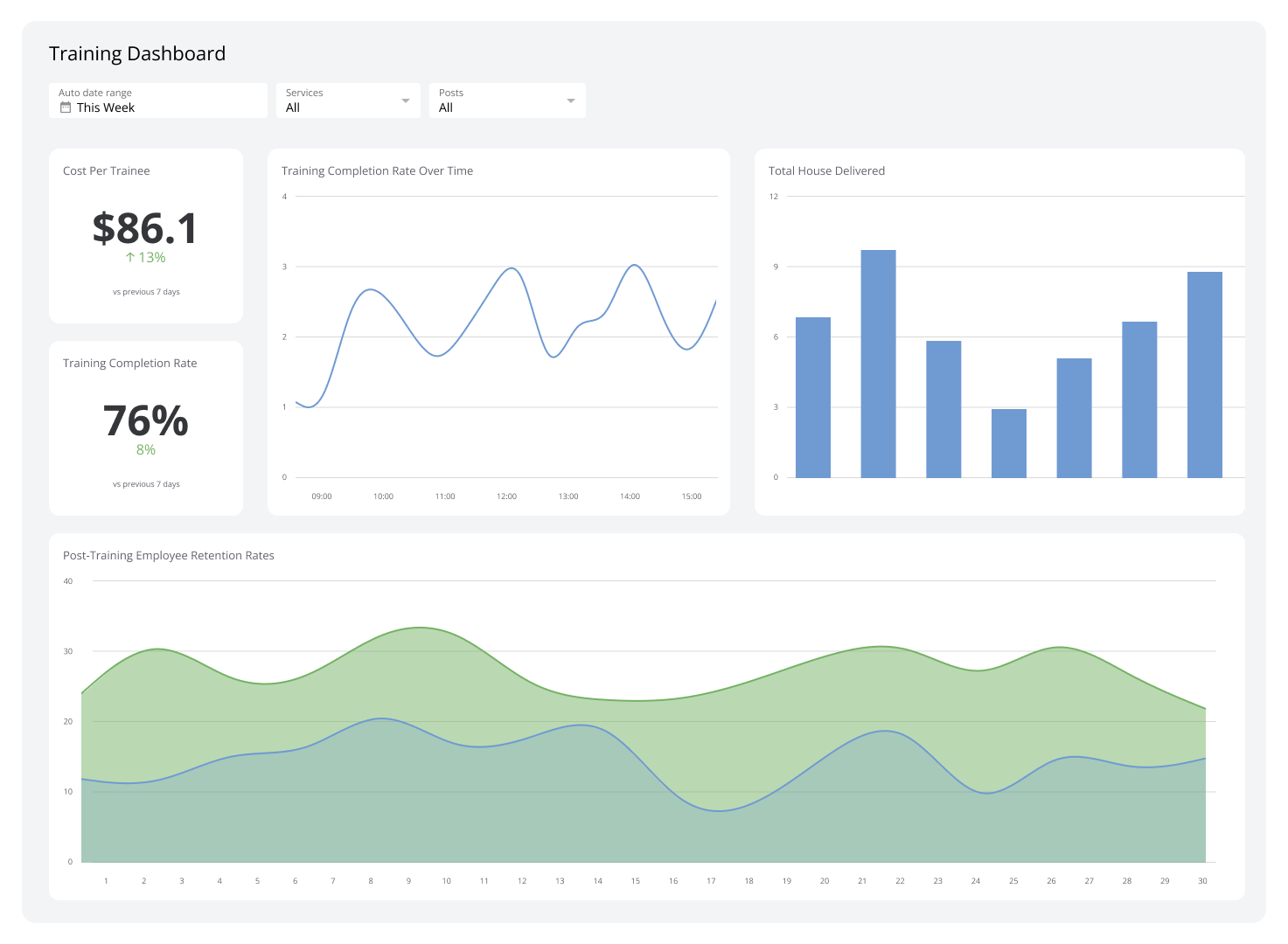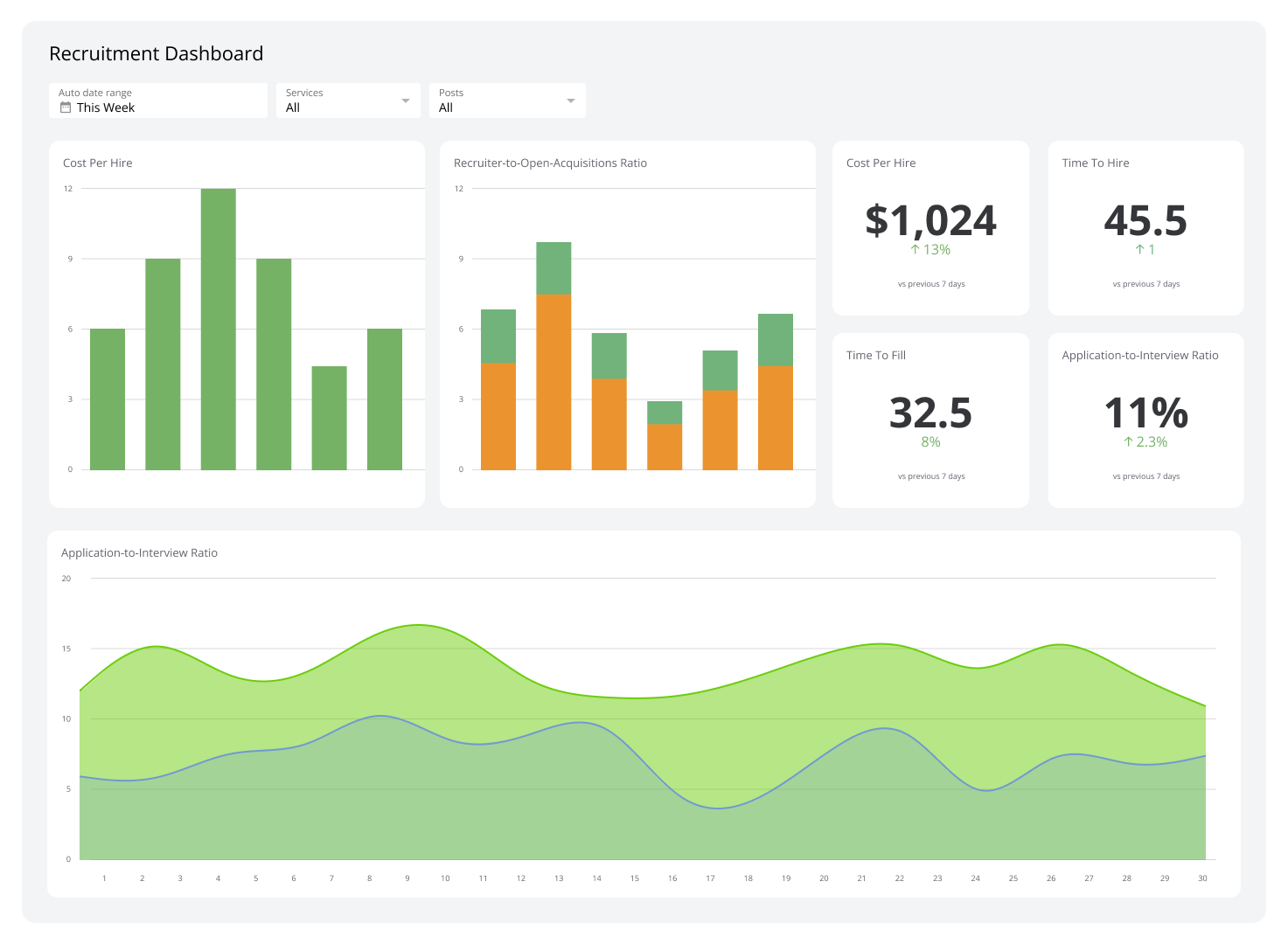Employee Engagement Dashboard
Understand your team's morale and build a better workplace with data.
What is an Employee Engagement Dashboard?
Low employee engagement is a costly problem. When employees are disengaged, productivity drops, and replacing talent becomes a major expense. So, how do you get an accurate read on how your employees are really doing?
An employee engagement dashboard is the answer. It gives HR leaders, managers, and executives a clear, data-driven picture of how employees feel about their work and the company. By tracking key metrics on morale, satisfaction, and retention in one place, you can move from guesswork to informed action. It’s the tool you need to find areas for improvement, cultivate a positive work environment, and keep your best people.
Why an employee engagement dashboard is important
If your HR data is stuck in different systems and spreadsheets, it’s nearly impossible to see the big picture. An employee engagement dashboard brings all that data together, providing a single source of truth that helps get everyone on the same page.
Here’s how it helps you build a better workplace:
- Spot trends early: Monitor changes in employee satisfaction or morale in real-time, allowing you to address issues before they become widespread problems.
- Make data-driven HR decisions: Use concrete data, not just anecdotes, to inform decisions about company culture, benefits, and management training.
- Improve employee retention: Understand the root causes of turnover by identifying patterns among departing employees and taking proactive steps to improve their experience.
- Boost team productivity: Engaged employees are more motivated and productive. A dashboard helps you see which teams are thriving and apply those learnings across the company.
Who benefits most from an employee engagement dashboard?
These dashboards are particularly valuable for leaders in small to mid-sized businesses who wear multiple hats. When you’re responsible for both strategy and execution, having clear data is critical.
- For HR Managers: Track key HR KPIs like turnover and absenteeism to measure the health of the organization and the impact of new initiatives.
- For Team Leaders: Get a pulse on your team’s morale and workload. Use the data to have more meaningful one-on-one conversations and provide targeted support.
- For Executives: See a high-level overview of company culture and organizational health, helping you make strategic decisions about workforce planning and long-term growth.
Key metrics for your employee engagement dashboard
An effective dashboard focuses on the metrics that matter most. While every company is different, here are a few essential KPIs to start with:
- Employee Net Promoter Score (eNPS): Measures how likely your employees are to recommend your company as a great place to work.
- Employee Turnover Rate: Tracks the percentage of employees who leave the company over a specific period.
- Absenteeism Rate: Monitors the rate of unplanned absences, which can be an early indicator of burnout or low morale.
- Employee Satisfaction Index (ESI): Gauges how satisfied employees are with their specific role and the workplace in general.
Why you should use a dashboard to track employee engagement
An HR dashboard focused on employee engagement is a critical tool for maintaining a healthy and productive workplace. By centralizing key HR data, you can move beyond guesswork and make informed decisions that benefit your team and your bottom line.
Get accurate insights into the state of your workforce
Highly engaged employees are 14% more productive and 81% less likely to be absent from work. But to foster that engagement, you first need to understand how your team is feeling. An employee engagement dashboard provides a real-time view of whether your team is happy, motivated, and committed.
With Klipfolio Klips, you can connect all of your data sources in one place. The tool integrates with various apps and platforms, including data warehouses, HR management systems, and project management software. This allows you to consolidate all relevant information and visualize it for a clear, comprehensive understanding of your workforce.
Measure the impact of initiatives
When you introduce new programs or policies, you need to know if they are making a difference. An engagement dashboard lets you measure the direct impact of these initiatives.
For example, if you launch a new wellness program, your dashboard can track metrics like absenteeism and employee satisfaction scores to see if the initiative is improving engagement. This data-driven feedback loop helps you see what works and what doesn’t, allowing you to allocate resources more effectively.
Predict employee turnover
High turnover is disruptive and expensive, creating costs for recruitment, training, and lost productivity. By using a dashboard to monitor engagement trends, you can identify early warning signs that employees might be planning to leave, such as declining satisfaction scores or participation rates.
For instance, if your dashboard shows a sudden drop in engagement within a specific department, HR can investigate the root cause and intervene early. This proactive approach can help you address issues before they lead to resignations, saving valuable team members from leaving.
Related Dashboards
View all dashboards4 important metrics for your engagement dashboard
An effective engagement dashboard tracks specific KPIs that provide valuable insights into your workforce’s sentiment. Here are the essential metrics to monitor to maintain a motivated and productive team.
- Employee turnover rate: This metric tracks the rate at which employees leave the company.
- Attrition rate: This focuses specifically on employees who leave voluntarily.
- Retention rate: This measures the percentage of employees who remain with the company over time.
- Turnover cost per person: This calculates the financial impact of replacing an employee.
Employee turnover rate
Your employee turnover rate is a key indicator of underlying issues with job satisfaction, company culture, or workload. Monitoring this metric helps you take targeted action to improve retention and create a more stable work environment, such as launching programs to boost morale or refining how tasks are delegated.
Attrition rate
While turnover includes all departures, the attrition rate focuses only on voluntary resignations. A high attrition rate is a strong signal of systemic problems like poor management, a toxic culture, or a lack of career growth opportunities. Tracking this metric on your dashboard allows you to pinpoint specific areas that need improvement to retain your top talent.
Retention rate
Retention rate is the inverse of turnover and attrition, showing the percentage of employees who choose to stay with your company over a given period. By keeping a close watch on retention metrics, you can identify which engagement strategies are most successful and double down on what works to build a loyal and committed workforce.
Turnover cost per person
Employee turnover is expensive. The total cost includes recruiting, advertising, training, and onboarding a replacement, as well as the loss of productivity during the transition. Tracking this metric highlights the direct financial drain of turnover on your company’s resources and profitability, making the business case for investing in engagement initiatives.
How to use your dashboard to improve employee engagement
Your dashboard is more than a reporting tool; it’s a strategic asset for improving your engagement initiatives and taking a proactive approach to boosting organizational health.
Analyze data to identify areas for improvement
One of the primary benefits of a dashboard is its ability to highlight areas where teams are struggling with engagement. This clarity is crucial for getting managers and executives on the same page and enables you to brainstorm data-backed strategies that effectively boost motivation and job satisfaction.
Develop strategies based on dashboard insights
The data on your engagement dashboard tells a story about your employees' experiences. Use these insights to develop targeted strategies that address specific challenges and opportunities.
For example, if the data reveals consistently low scores on employee satisfaction surveys, consider implementing new wellness programs or enhancing professional development opportunities. This data-driven approach ensures your solutions directly address your employees' most pressing needs.
Predict trends for proactive engagement management
Beyond showing historical performance, a well-designed employee engagement dashboard helps you identify patterns and forecast future issues.
For example, if your dashboard reveals a gradual increase in voluntary attrition over several quarters, you can investigate and address potential causes, such as workload creep or a lack of growth opportunities. By proactively tackling these issues, you can prevent further talent loss and cultivate a more engaging and supportive workplace environment.
Challenges in using employee engagement dashboards
While powerful, an employee engagement dashboard is only as good as the data and processes behind it. Data accuracy, employee participation, and handling qualitative feedback are three common challenges you might face. Let’s take a closer look at each one.
Data accuracy
Inaccurate data can mislead managers, leading to poor decisions that may harm employee morale rather than help it. To maintain data accuracy, regularly audit your data sources and implement automated data validation to catch errors early. Ensure that metrics are calculated consistently across all systems to create a single source of truth for your engagement reporting.
Employee participation
Low participation in surveys and feedback requests can skew the data on your engagement dashboard. If only a small, unrepresentative portion of your workforce responds, the data will not reflect the overall sentiment accurately. Encourage higher participation by clearly communicating the purpose of the feedback, guaranteeing anonymity to foster honest responses, and demonstrating that employee input leads to tangible changes.
Qualitative data
Dashboards are excellent for displaying quantitative data but can struggle to capture the nuance of qualitative feedback, such as employee sentiments and open-ended comments. Relying only on numbers can result in a superficial understanding of the root causes behind engagement issues.
To address this, complement your dashboard with qualitative data gathered from interviews, focus groups, or open-ended survey questions. You can then analyze this feedback for common themes and even visualize it on your dashboard using word clouds or sentiment trend charts. This mixed-method approach provides the context needed to understand the story behind the numbers.
Build a better workplace with Klipfolio
An employee engagement dashboard helps you listen to your team, address their needs, and enhance job satisfaction, allowing you to retain top talent and build a stronger business. With Klipfolio Klips, you can connect your HR data sources and create clear, insightful visualizations tailored to your unique engagement metrics.
Build your employee engagement dashboard with Klipfolio Klips and start developing targeted strategies to foster a positive and productive work environment.



